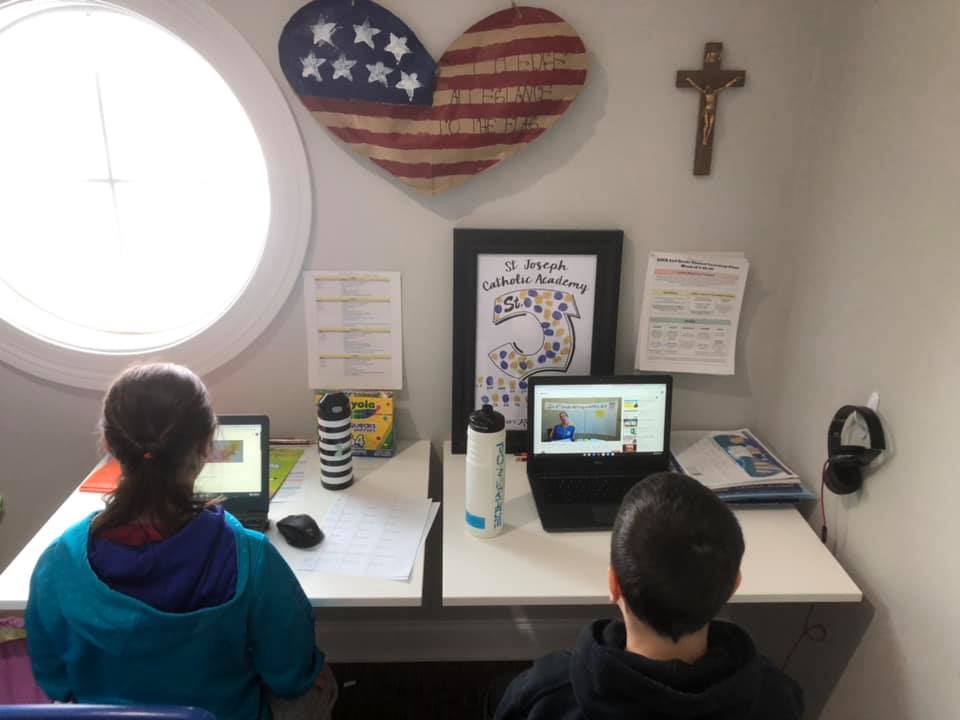KAREN MAHONEY
SPECIAL TO THE CATHOLIC HERALD
The outbreak of COVID-19 continues to create issues in all walks of life, especially for those involved in education. While life has drastically changed, one thing that has not changed is the quality of education throughout the schools in the Archdiocese of Milwaukee. The high quality of student performance is supported by the evidence that students in Catholic schools score well above the national average in reading, language, mathematics, science, and social studies.

Students at Catholic schools across the archdiocese have adjusted to distance learning during the current health crisis. (Submitted photo)
At St Joseph Catholic Academy, a pre-K through grade 12 school in Kenosha, the faculty exceeds staff expectations with their commitment to distance learning, demonstrating not only their academic expertise, but even more impressive, their commitment, dedication and love for their students, said SJCA President Bob Freund.
“Despite the distance, our counselors, teachers, administrators and principals find innovative and compassionate ways to reach out and support those students who are struggling, whether it be academically, socially or emotionally,” he said. “All middle and high school teachers provide virtual office hours for students every day.”
Additionally, for students needing some extra help with math homework, the middle and high school lab continues to run each week after class hours.
Younger students learn their prayers, the Pledge of Allegiance, craft projects and how to be a line leader through videos their teachers post online.
As with in-person learning, teachers at St. Francis Borgia School in Cedarburg take virtual learning seriously. Each Sunday evening, students and parents receive an itemized learning schedule outlining virtual calls, homework due dates and assignment expectations. The schedule helps students stay organized, said Erika LaPean, marketing and development director.
“Our teachers wanted to make sure that students were still learning in the same robust manner that they left behind in the physical classroom,” she said, “The curriculum for each grade hasn’t varied a whole lot from the original plan.”
Students study individually and in groups of varying sizes. Classes in grades one through eight are taught in a virtual classroom-style setting where students are listening and watching live instruction from their teacher.
“All of the grades have incorporated virtual field trips and social calls into their schedule so that the students can still interact in a fun way just as if they were at school,” said LaPean. “We still see students laughing with each other.”
The very day schools closed in the state, Notre Dame School of Milwaukee, which has co-ed primary, boys middle school, and a girls middle school on a separate campus, instituted online classes to ensure their 4K through eighth-grade students continued with uninterrupted learning. Whether in-person or online, teachers provide students with a solid academic foundation to prepare them for future success in high school and beyond.
Throughout the weekend of March 14-15, staff created a plan to make the collaborative virtual learning environment as seamless as possible. The following Monday, staff distributed learning materials and 150 Chromebooks to students without a computer in the home.
Through Class Dojo and Google Classroom, teachers remain in contact with students and families, take attendance, and assign and receive homework. Students can work alone or in groups through online platforms and attend virtual classes and group meetings through Zoom. In turn, parents are uploading videos to teachers of their students engaging in lessons at home.
At St. Robert School in Shorewood, teachers and staff transitioned with their students in grades 4K through eight to transform their in-school curriculum to a distance learning model in just a couple of days. Parental response has been positive, said Kristi Felber, marketing and engagement director.
“Teachers provide time each day for parent consultation by email, phone and video conference to support them in guiding their children’s learning at home,” she said. “Some teachers have also created closed Facebook pages to allow parents to inspire one another and share homeschooling experiences.”
The school’s youngest students use an e-resource to upload their work and receive feedback from their teacher in real time. Other teachers hold small-group book clubs and class discussions. Students with special needs receive reading support via videoconferencing.
“Students are even continuing instrumental lessons via videoconference,” said Felber. “And most impressive of all, our teachers are supporting each other across grade levels and disciplines to ensure that excellence continues in new and creative ways while we are not in our brick and mortar building.”
On March 18, students from Marquette University High School logged on to their virtual classrooms for the first time. Their teachers created an online learning class schedule with eight distinct class periods from 9 a.m. to 1:40 p.m. each day. Thanks to their exemplary educational model, students will conclude their 2019-20 school year with very little loss of instruction.
To maintain their rigorous, college-preparatory curriculum, Scott Rudie, vice president of communications and marketing, said every teacher closely monitors student attendance and participation.
“All teachers keep virtual office hours from 8 to 9 a.m. and 1:40 to 2:40 p.m. as an additional way for students to connect with teachers for help,” he said, adding, “Check-in surveys were sent to parents and students to continually access the effectiveness of the Marquette High virtual learning program.”
